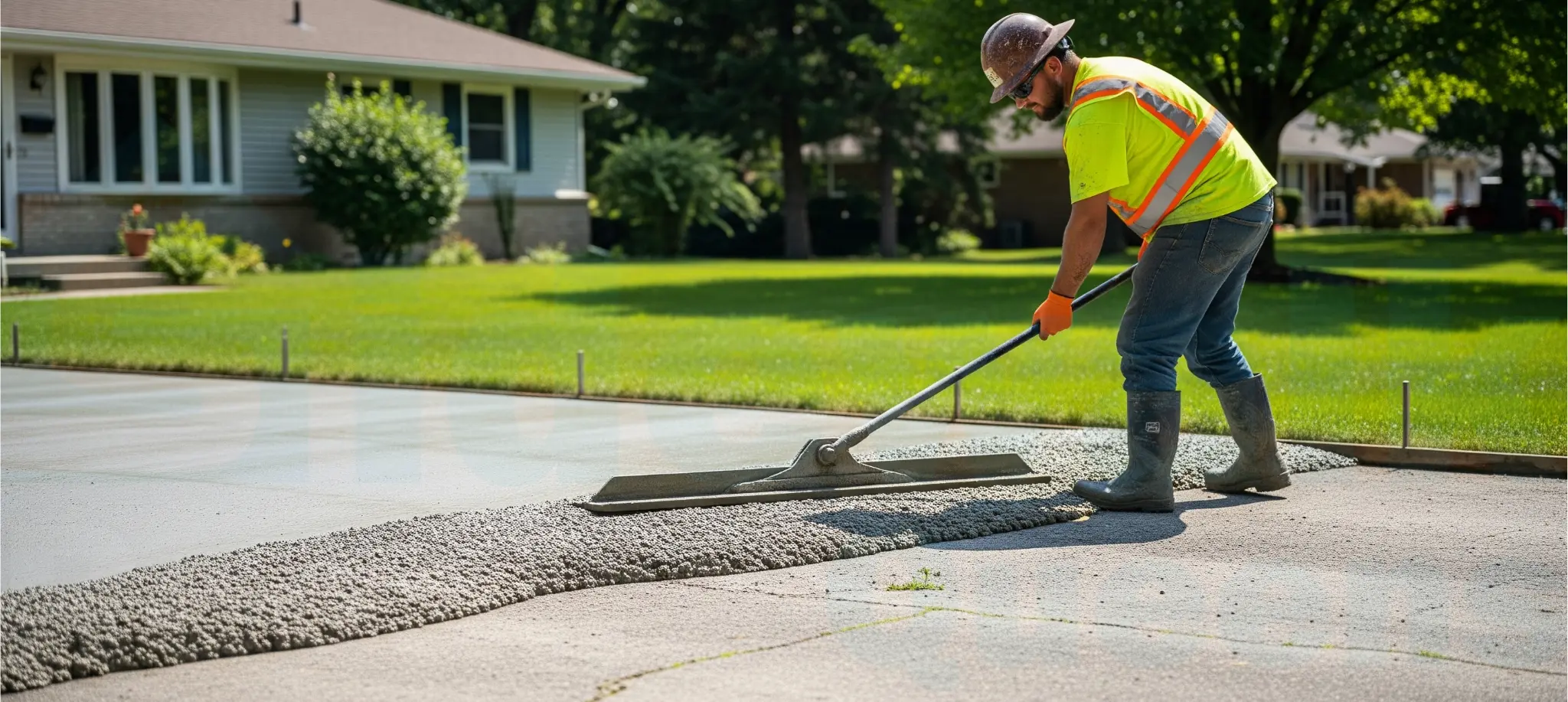
Can You Pour Concrete Over an Existing Concrete Driveway?
Concrete is one of the most trusted materials in construction, especially when it comes to driveways. It’s durable, reliable, and designed to take on everything from scorching summer heat to freezing winter storms. But even concrete isn’t invincible.
Over time, that once-smooth driveway can start to look worn down. Maybe you’re noticing hairline cracks creeping in. Or perhaps the surface is looking patchy, dull, or just plain tired. These small issues can leave homeowners asking a big question: Do I have to tear the whole thing out, or can I just pour new concrete on top?
Let’s walk through what that actually involves and whether it’s the right move for your home or if a concrete overlay service is right for you.
Can You Add a New Concrete Layer Over an Old Slab?
Yes, you can pour a new layer of concrete over an existing one, but it’s not a one-size-fits-all solution. If your current driveway is still in fairly solid condition, with no major cracks, no crumbling, and no shifting, then a concrete overlay might work.
The key here is proper preparation. You can’t just dump new concrete on top of old and hope it sticks. The existing surface needs to be cleaned, etched, and prepped for bonding. Our team in Queens handles this professionally, ensuring long-lasting overlays.Skipping that step? The overlay may peel, crack, or fail much sooner than expected.
However, if your driveway is already showing signs of structural failure, like wide cracks, uneven spots, or sinking sections, then an overlay won't cut it. It won’t fix what’s underneath. In fact, it could actually make things worse by hiding the problems instead of solving them.
When Should You Avoid Pouring Concrete?
Here’s where things get tricky. Not every driveway is a suitable candidate for an overlay. Some warning signs mean it’s better to rethink the strategy altogether:
Water Pooling: If puddles form after it rains, it’s a sign of improper drainage. A new layer will only mask that issue, not fix it.
Widespread Cracking: Spiderweb or hairline cracks are one thing. But if you’ve got cracks big enough to slide a coin into, an overlay will just be a temporary bandage.
Sinking or Lifting Sections: If your driveway feels bumpy or visibly dips in areas, you’re dealing with foundation problems. An overlay won’t stabilize those weak spots, it’ll just mirror the issues later.
Often, these problems trace back to poor installation or rushed curing of the original concrete. If the base wasn’t properly compacted, or the concrete dried too fast, it can weaken the slab, and overlays won’t magically reinforce it.
Other Options to Restore Your Driveway
So, what if an overlay isn’t the right choice? The good news is that homeowners still have other options, some of which can be both effective and budget-friendly.
Resurfacing
If your driveway just has surface-level flaws, minor pitting, fading, or small chips, resurfacing might be the best fix. This involves applying a thin coating (often acrylic- or epoxy-based) to the surface. It doesn't add much height, and it allows for plenty of customization.
You can choose from different colors, patterns, and finishes. There are even resurfacing systems that give the appearance of stamped concrete without the cost of a full pour.
Staining
For structurally sound driveways that just need a facelift, concrete staining is a great option. Acid stains or water-based stains can bring back depth, color, and vibrancy. This doesn’t solve physical damage, but it can dramatically improve aesthetics, especially for concrete that’s faded from years of UV exposure.
However, if the damage runs deeper, like crumbling sections, major shifting, or deep-rooted cracks, then none of these surface solutions will hold up. A full driveway replacement may be necessary.
Get Professional Help
One of the biggest missteps homeowners make is going the DIY route without understanding the condition of their existing driveway. Pouring new concrete might seem easy on paper, but skipping proper evaluation can lead to expensive regrets.
A qualified contractor can assess your concrete’s condition, test its stability, and determine whether an overlay, resurfacing, or full replacement is the right path forward.And a good one will never recommend pouring new concrete over a failing or damaged surface.
Conclusion
On paper, pouring new concrete over an existing driveway feels like a clever shortcut, a fresh finish without the mess or price of a full replacement. But in reality, it’s only a good idea if your existing concrete is in decent shape and the surface is properly prepped.
If your driveway is already cracking, sinking, or suffering from drainage issues, an overlay may not just fail; it might make the problem worse. In these cases, fixing the root issue is always smarter than covering it up.
Making the right decision starts with understanding the problem and knowing your options. Whether you’re dealing with cosmetic wear or structural headaches, there's a path forward that can restore your driveway’s function, appearance, and longevity.
Not sure what your driveway really needs? Don’t guess, just get answers.
At Sidewalk Repairs Queens, we take the guesswork out of concrete repairs. Our experienced team will evaluate your existing slab, explain the options clearly, and help you choose between an overlay, resurfacing, or full replacement, based on what’s best for your property, not just a quick fix.
Call us today for a free estimate or schedule a site visit anywhere in Queens.
Let’s bring your driveway back to life safely, affordably, and professionally, with durable and long-lasting repairs.